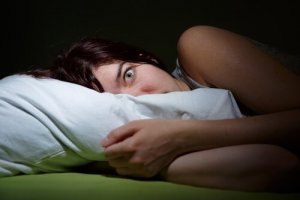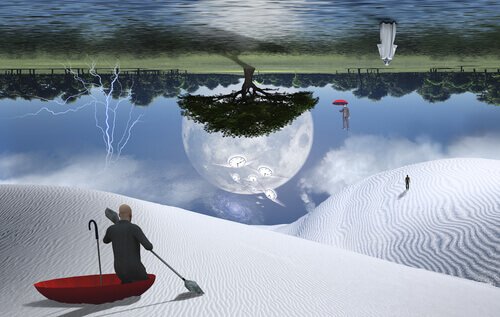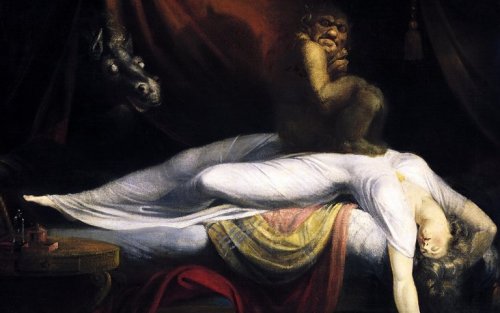Sleep Paralysis

Sleep paralysis, scientifically known as hypnagogia, is a vivid perceptual experience that occurs at the beginning of the sleep cycle. Furthermore, hypnagogic hallucinations are highly vivid dreams full of visual, tactile, and auditory phenomena. In contrast, hypnopompic hallucinations are similar experiences that manifest when the person wakes up.
The term, coined by Frederic W. H. Myers from Hypnos (sleep) and pomp (a sending) was used for the first time in 1918 in reference to hypnopompic hallucinations. In addition, it served to describe the phenomena that happened during the transition between sleeping and awakening.
French psychiatrist Baillarger first described hypnagogic hallucinations in 1846. He also called them psychosensorial hallucinations. Moreover, the term Hypnos (sleep) and agogos (induced) designates hallucinations or illusions that announce a dream, according to Alfred Maury.
Thus, these hallucinations manifest when a person believes to be awake. They can see, hear, and feel, but can’t move. Furthermore, hypnagogic hallucinations are closely related to sleep paralysis.

Prevalence and history of hypnagogic hallucinations
The prevalence of hypnagogic and hypnopompic hallucinations among the general population is 25-30% of those affected by narcolepsy (2). In 1957, authors Yoss and Daly included these hallucinations in their diagnostic criteria of narcolepsy. These hallucinations are also characteristic of excessive daytime sleepiness disorders. They were often observed in patients who experienced sleep paralysis before falling asleep (3.4).
In addition, psychoactive substances such as khat (5) and hashish (6) induce both hypnagogic and hypnopompic hallucinations.
Sleep paralysis and hypnagogic hallucinations
Sleep paralysis consists of a generalized and transient inability to move or speak. It fundamentally occurs during the sleep-wake transition when hypnagogic hallucinations manifest.
A long time ago, sleep paralysis and hypnagogic hallucinations were important characteristics of nightmares. Popular culture embellished these symptoms with supernatural meanings. Thus, some believed that sleep paralysis and hallucinations were caused by demonic visits.
In 1834, McNish defined nightmares for the first time:
“Imagination cannot conceive the horrors it [the nightmare] frequently gives rise to, and language can’t describe them in adequate terms . . . Everything horrible, disgusting, or terrifying in the physical or moral world is brought before him in fearful array; he is hissed at by serpents, tortured by demons, stunned by the hollow voices and cold touch of apparitions . . . At one moment he may have the consciousness of a malignant demon being at his side; then to shun the sight of so appalling an object, he will close his eyes, but still the fearful being makes its presence known; for its icy breath is felt diffusing itself over his visage, and he knows that he is face to face with a fiend. Then, if he looks up, he beholds horrid eyes glaring upon him, and an aspect of hell grinning at him with even more hellish malice.“
When one reads this and other similar reports, it becomes clear that the term ‘nightmare’ has changed in the last 150 years. It now denotes highly vivid, unpleasant dreams that produce fear and multiple awakenings.

Incubus: The nocturnal demon
In his book On the Nightmare, Ernest Jones explains that the word nightmare originally meant “incubus” (male demon). These nocturnal demons were responsible for the frightening experiences in dreams, according to local folklore.
An incubus is a demon that, according to popular European Middle-Age methodology, climbed on top of sleeping women and attacked them. Legend has it that the demon’s intention was to rape them, sometimes with the purpose of impregnating them, as told in the legend of Merlin. (8) His feminine counterpart, who climbs on top of sleeping men, is a succubus.
People believed that incubi visited people at night and laid on their chest, immobilizing them. Moreover, Jones points out that this belief was almost universal. Thus, it seems that the hypnagogic hallucinations of which we speak of are, in a certain way, caused by nocturnal demons.
In conclusion, these hallucinations are currently studied as symptoms of narcolepsy. However, they also occur in healthy people. (9)
Sleep paralysis, scientifically known as hypnagogia, is a vivid perceptual experience that occurs at the beginning of the sleep cycle. Furthermore, hypnagogic hallucinations are highly vivid dreams full of visual, tactile, and auditory phenomena. In contrast, hypnopompic hallucinations are similar experiences that manifest when the person wakes up.
The term, coined by Frederic W. H. Myers from Hypnos (sleep) and pomp (a sending) was used for the first time in 1918 in reference to hypnopompic hallucinations. In addition, it served to describe the phenomena that happened during the transition between sleeping and awakening.
French psychiatrist Baillarger first described hypnagogic hallucinations in 1846. He also called them psychosensorial hallucinations. Moreover, the term Hypnos (sleep) and agogos (induced) designates hallucinations or illusions that announce a dream, according to Alfred Maury.
Thus, these hallucinations manifest when a person believes to be awake. They can see, hear, and feel, but can’t move. Furthermore, hypnagogic hallucinations are closely related to sleep paralysis.

Prevalence and history of hypnagogic hallucinations
The prevalence of hypnagogic and hypnopompic hallucinations among the general population is 25-30% of those affected by narcolepsy (2). In 1957, authors Yoss and Daly included these hallucinations in their diagnostic criteria of narcolepsy. These hallucinations are also characteristic of excessive daytime sleepiness disorders. They were often observed in patients who experienced sleep paralysis before falling asleep (3.4).
In addition, psychoactive substances such as khat (5) and hashish (6) induce both hypnagogic and hypnopompic hallucinations.
Sleep paralysis and hypnagogic hallucinations
Sleep paralysis consists of a generalized and transient inability to move or speak. It fundamentally occurs during the sleep-wake transition when hypnagogic hallucinations manifest.
A long time ago, sleep paralysis and hypnagogic hallucinations were important characteristics of nightmares. Popular culture embellished these symptoms with supernatural meanings. Thus, some believed that sleep paralysis and hallucinations were caused by demonic visits.
In 1834, McNish defined nightmares for the first time:
“Imagination cannot conceive the horrors it [the nightmare] frequently gives rise to, and language can’t describe them in adequate terms . . . Everything horrible, disgusting, or terrifying in the physical or moral world is brought before him in fearful array; he is hissed at by serpents, tortured by demons, stunned by the hollow voices and cold touch of apparitions . . . At one moment he may have the consciousness of a malignant demon being at his side; then to shun the sight of so appalling an object, he will close his eyes, but still the fearful being makes its presence known; for its icy breath is felt diffusing itself over his visage, and he knows that he is face to face with a fiend. Then, if he looks up, he beholds horrid eyes glaring upon him, and an aspect of hell grinning at him with even more hellish malice.“
When one reads this and other similar reports, it becomes clear that the term ‘nightmare’ has changed in the last 150 years. It now denotes highly vivid, unpleasant dreams that produce fear and multiple awakenings.

Incubus: The nocturnal demon
In his book On the Nightmare, Ernest Jones explains that the word nightmare originally meant “incubus” (male demon). These nocturnal demons were responsible for the frightening experiences in dreams, according to local folklore.
An incubus is a demon that, according to popular European Middle-Age methodology, climbed on top of sleeping women and attacked them. Legend has it that the demon’s intention was to rape them, sometimes with the purpose of impregnating them, as told in the legend of Merlin. (8) His feminine counterpart, who climbs on top of sleeping men, is a succubus.
People believed that incubi visited people at night and laid on their chest, immobilizing them. Moreover, Jones points out that this belief was almost universal. Thus, it seems that the hypnagogic hallucinations of which we speak of are, in a certain way, caused by nocturnal demons.
In conclusion, these hallucinations are currently studied as symptoms of narcolepsy. However, they also occur in healthy people. (9)
All cited sources were thoroughly reviewed by our team to ensure their quality, reliability, currency, and validity. The bibliography of this article was considered reliable and of academic or scientific accuracy.
-
Ohayon, M. M., Priest, R. G., Caulet, M., & Guilleminault, C. (1996). Hypnagogic and hypnopompic hallucinations: pathological phenomena?. The British Journal of Psychiatry, 169(4), 459-467.
- Broughton, R. (1982) Neurology and dreaming@ Psychiatric Journal of the University of Ottawn, 7,101-110.
- Goode, G. B. (1962) Sleep paralysis. Archives of Neurology, 6, 228-234.
-
Hishikawa, Y. (1976). Sleep paralysis. Advances in sleep research, 3, 97-124.
-
Granek, M., Shalev, A., & Weingarten, A. M. (1988). Khat‐induced hypnagogic hallucinations. Acta Psychiatrica Scandinavica, 78(4), 458-461.
-
Baillarger, M. (1846). Des hallucinations psycho-sensorielles. Ann Méd Psychol, 7, 1-12.
-
Liddon, S. C. (1967). Sleep paralysis and hypnagogic hallucinations: Their relationship to the nightmare. Archives of general psychiatry, 17(1), 88-96.
-
Lacy, N. J., Ashe, G., Ihle, S. N., Kalinke, M. E., & Thompson, R. H. (2013). The New Arthurian Encyclopedia: New edition. Routledge.
-
Martínez-Rodríguez, J. E., & Santamaría, J. (2005). Narcolepsia e hipersomnia idiopática. Rev Méd Univ Navarra, 49(1), 35-40.
This text is provided for informational purposes only and does not replace consultation with a professional. If in doubt, consult your specialist.







